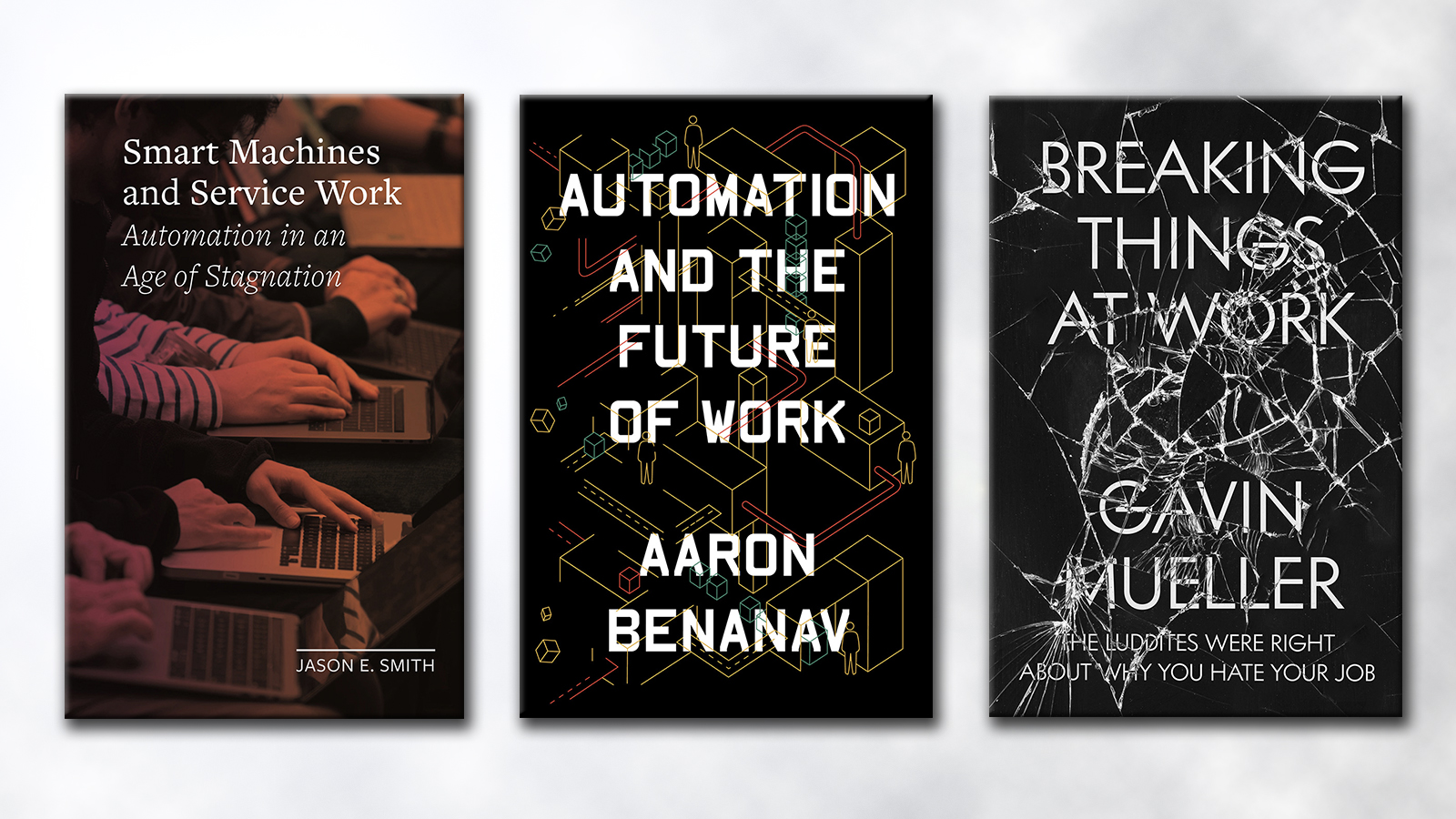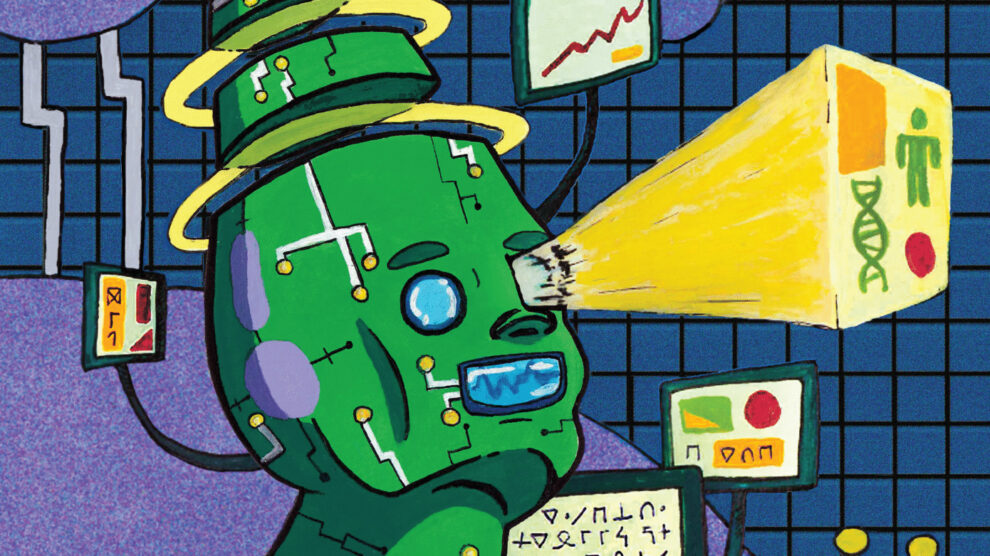Rage Against the Machines
On Automation and Work
By Nafis Hasan
Volume 24, Number 2, Don’t Be Evil
 Automation has replaced workers in a post-industrial economy, resulting in job scarcity, worker precarity, and wage stagnation. But it doesn’t have to be this way: smart machines, driverless cars, and skilled robot workers can also liberate us from our drudgery. Instead of selling our labor for wages, we would be paid a Universal Basic Income (UBI) and would be free to pursue our desires. This is the utopia that proponents of automation—Silicon Valley elites, neoliberals, and left-wing thinkers alike—would have us believe.
Automation has replaced workers in a post-industrial economy, resulting in job scarcity, worker precarity, and wage stagnation. But it doesn’t have to be this way: smart machines, driverless cars, and skilled robot workers can also liberate us from our drudgery. Instead of selling our labor for wages, we would be paid a Universal Basic Income (UBI) and would be free to pursue our desires. This is the utopia that proponents of automation—Silicon Valley elites, neoliberals, and left-wing thinkers alike—would have us believe.
This popular myth is what both Aaron Benanav and Jason E. Smith set out to debunk in their books, Automation and the Future of Work and Smart Machines and Service Work: Automation in an Age of Stagnation, respectively. Smith and Benanav counter the narrative that automation, as well as labor-saving technologies that augment, without replacing, human labor, are responsible for the low demand of labor, leading to joblessness. Instead, they argue that economic stagnation due to deindustrialization, disinvestment, and manufacturing overcapacity (Benanav) and a lack of capital investment by the rising technological bubble (Smith) are the main drivers towards a future where workers are forced to compete with each other for any available work.
Regardless of its role in creating joblessness, whether automation can liberate the working class forms a central question in Gavin Mueller’s Breaking Things at Work. He posits that “[technology developed by capitalism] compels us to work more, limits our autonomy, and outmaneuvers and divides us when we organize to fight back.” To break free of this hold, Mueller insists that we must learn from the Luddites, workers who organized between 1811 and 1812 under the mythical “Ned Ludd” to attack and destroy machinery introduced by textile mill owners in England, to prevent encroachment of their labor. By seizing the means of production through such resistance, we can move society towards a future where technology is one component of a socialist whole, rather than as a decontextualized means to our liberation under capitalism.
The Underemployment Crisis
Benanav examines global trends in manufacturing and GDP, labor productivity growth rates, and the productivity-wage gap between 1950 and 2017 across the globe to show that economies worldwide are deindustrializing, that is, the share of manufacturing jobs in total employment is declining.1 While automation theorists pair job decline with “rising productivity” to claim that machines are taking away people’s jobs, Benanav explains that, in fact, our productivity growth rate is falling even as overall productivity is increasing.
For Benanav, a falling productivity growth rate creates a “persistently low demand for labor” while an “army of reserve labor keeps growing,” leading to precarity for workers. This chronic underemployment manifests in massive unemployment spikes during economic crises such as the 2008 financial crash, and consequently contributes to growing income inequality by allowing exploitation and falling wages due to available surplus labor. The lack of protection stemming from historical decline in both union density and power, especially in the US, compounds the vulnerability of workers.
By seizing the means of production, we can move society towards a future where technology is one component of a socialist whole, rather than as a decontextualized means to our liberation under capitalism.
Smith and Benanav both dispel the notion that there was an economic recovery from the 2008 crash by attributing it to stagnating wages, and a “collapse in labor productivity gains.” To highlight the severity of the situation, Smith cites the 2018 Bank of England report that shows that average productivity growth between 2008 and 2018 has been the worst of any decade since the eighteenth century. The root cause of this situation, Smith argues, stems from the rise of “Big Tech” after the dot com crash in 2000. These companies, instead of fulfilling the promise of an “exponential takeoff in productivity” by investing profits in innovation, spent billions on stock buybacks that drove up their share prices and “starved” capital investment while benefiting shareholders. They also engaged in “cross-subsidization,” whereby they offered goods and services below market price to capture users and stifle competition, with the ultimate goal of monopolizing the market.
Smith builds on historical accounts of worker displacement, particularly that of James Lee Boggs, who feared that displaced factory workers in the 1950s and 1960s would have nowhere to go, to show how an expanding service sector absorbed most of these workers in low-paying jobs that comprise the “servant economy.”2 Benanav similarly shows the rise in service sector employment in the last two decades. These jobs, making up 70 to 80 percent of advanced economies, frequently take place in workplaces that are atomized, dispersed, and surveilled using advanced technologies, thus hindering workers from collectively organizing to gain concessions from their employers.
The Servant Economy
The service sector in sluggish advanced economies, is a prime location for the exploitation of the underemployed working class. Benanav argues that, because there is a labor surplus, workers will reduce their own wage demands to secure employment. Since economic growth will keep decelerating, the labor surplus will keep growing. Therefore, this vicious cycle will keep propagating the rise in inequality. Instead of the poor getting poorer, Benanav claims that poorer workers’ share of overall income growth will remain much smaller. Here he cites Thomas Piketty and colleagues, who show that, between 1980 and 2016, the poorest half of the global population accounted for only 12 percent of overall income growth compared to 27 percent by the richest 1 percent.3
The US Bureau of Labor Statistics’ projections for employment until 2024 show that 19 out of 20 new jobs will be in the service sector, mostly in low wage and low skill categories. This expansion of low skill work is due to automation of “administrative, clerical and office work,” Smith argues, compared to previous mechanization of repetitive work in agriculture and factories. He contends that automation today is not simply taking away jobs, but is rather replacing tasks. For example, human bank tellers have shifted their focus away from handling deposits and withdrawals to marketing credit cards and loans. Meanwhile, the ATM is replacing “the bank employee’s labor not with a machine, but with the free labor of its user.” Smith further posits that the rise of “personal service” jobs is due to “the rising consumption of services in response to cheaper and manufactured goods,” and claims that the existence of cheap labor due to underemployment is the reason that “full” automation is not possible: “[I]n a world of abundant cheap labor, there is no compulsion to economize on labor inputs.”4
A crucial part of understanding the more insidious aspects of partial automation is the distinction between high skill and low skill jobs. Smith shows that while both these categories rely on intuition and interpersonal contacts, high skill jobs are often related to managing the labor force itself. Thus, to the capitalists, automating the mid-level clerical and administrative jobs provides a greater control of the labor force. While futurists and techno-utopians have long heralded the “second machine age” to be one of liberation from the grind, it appears that, under capitalism, this liberation—if imminent—will be reserved for the rich.
In Ludd We Trust
Socialists are not immune to the allure of a techno-utopian vision. From Bolsheviks to fully automated luxury communists, grand ideas of how technology will liberate the working class abound. In reality, automation and technology have become tools of the capitalist ruling elite to enforce social control, from robot police dogs in poor neighborhoods to supervisory roles in Amazon and Walmart warehouses—they are direct products of capitalism that further its goals.
Gavin Mueller traces the history of worker opposition to use of machines in the workplace, from as early as the 1630s to the present day, to show that, despite the usual mockery associated with Luddites, similar traditions have continued. More importantly, this opposition was not against machines per se, but rather against the effects that introducing machines would have on their work, validating Marx’s analysis: “[S]urplus-value does not arise from the labour-power that has been replaced by the machinery, but from the labour-power actually employed in working with the machinery.”5 From striking miners to longshoremen, female telephone operators, Black Panthers and Civil Rights leaders like Martin Luther King, Jr., Bayard Rustin, and more, Mueller details how workers repeatedly rebelled against their alienation from their labor through the introduction of machinery in the name of efficiency.
Technology, developed under the auspices of capitalism, cannot be simply co-opted for our struggles; rather, we have to be intentional about what kind of technology we want to see produced for our liberation.
Both Mueller and Smith show that current day automation can only take place in supervisory roles and jobs that require repetitive physical activity, and realize Frederick Taylor’s fantasy of scientific management. In fact, surveillance technologies, both in the logistics process of just-in-time production, and in cyberspace via personalized ad targeting, are already in motion, enforcing social norms and influencing our behaviors. Drawing on the work of Shoshanna Zuboff, Mueller concludes, “[I]t is not simply that the relations between technology companies and the rest of us are extractive…it is rather the restructuring of behavior in directions directly productive of commodities.”6
In cruel irony, man is becoming the automaton, a word initially used to describe living processes but later applied solely to machinery.7
You Don’t Hate Mondays, You Hate Capitalism
The German social psychologist Erich Fromm, writing on Marx’s concept of labor, postulated that “work is for [Marx] the active relatedness of man to nature, the creation of a new world, including the creation of man himself.”8 Under capitalism, this relationship is altered such that the product of human labor, whether intellectual or physical, becomes estranged: “[T]he laborer exists for the process of production, and not the process of production for the laborer.” To break this alienation, the worker needs to wrest control of the production process from capitalism, which is fundamentally about the social relations between humans, and, as Mueller articulates, between humans and machines. Thus, instead of abolishing work, it is the social relations governing our labor that we must change; as the adage goes, “You don’t hate Mondays, you hate capitalism.” All three authors agree as much; the question, then, is what to do about it.
Left-wing automation theorists have proposed that a UBI, once instituted, would empower workers to challenge the power of capital and organize to take over the means of production, thus transforming social relations.9 Benanav contends that such proposals put “the cart before the horse”: for a UBI to be large enough to empower workers, workers must be organized enough to be able to win such a large demand. Without organized workers and a viable path to challenging capitalist control of production, UBI proposals will fail to deliver promised liberation. Instead, Benanav proposes that to achieve a “post-scarcity” future where people’s livelihood is not tied to work, it is important to determine what constitutes “necessary” work. Such determination can be possibly made by solving the twentieth century socialist calculation debate—how to organize the economy in the absence of value, money, and private ownership—using twenty-first century technology.10
While Smith remains deeply skeptical of the power of the working class, he nonetheless offers the examples of teacher militancy in the United States and the workers’ opposition to Macron’s administration in France as examples of how workers can strategically oppose the power of capital. He draws the connection between the 2020 union-led transport strike in France that immobilized the economy and the gilets jaunes movement in which non-unionized workers participated.11 In the latter case, he argues that most of these workers are “excluded from the economy in more than one sense”; it is these “outsiders” (à la Boggs) who he believes will bring about the “new way to live,” without the meddling of unions and liberals, who have historically failed them.
In a similar vein to Benanav, Mueller proposes a decelerationist politics centered on Marxist Luddism, “an antagonism toward the progress of elites at the expense of the rest of us.” He points out such nascent politics in the Right to Repair movement and the similarities between recent Degrowth ideology and Luddism, mainly that “liberation is not tied up with endless accumulation of capital, and further, that well-being cannot be reduced to economic statistics.”
It is, of course, not possible to encompass the entirety of changing working class composition along with decades-long economic patterns in a single book. But what is critically missing from Smith’s and Benanav’s works are the gendered and racial aspects of the working class in relation to automation. Historically, automation in the automobile industry mostly displaced Black workers, and the service sector has been dominated by non-white, immigrant, and female workers.12 In fact, existing income inequalities between the average Black worker and the white worker in the United States warrant this discussion in the light of deindustrialization and expansion of the service sector. Regrettably, there exists scant literature by authors of color on automation and its effects on workers, which makes Ruha Benjamin’s Race After Technology all the more important to read alongside these books. Smith and Benanav also do not engage with proposed jobs guarantee programs, and how those would fare in an economy with chronic underemployment.
Despite such shortcomings, these books provide a sweeping assessment of the economy we inherited and demonstrate why we should not be fooled by the prophets of automation. Technology, developed under the auspices of capitalism, cannot be simply co-opted for our struggles; rather, we have to be intentional about what kind of technology we want to see produced for our liberation. Though scant on the details on how to organize a decomposing working class, the books nonetheless give us a vision for our future that is contrary to what has been peddled by techno-utopians. As Benanav writes, “without a clear vision of this coming world, it is easy to get lost along the way.”
Smart Machines and Service Work: Automation in an Age of Stagnation
Jason E. Smith
Reaktion Books
2020
192 pages
Automation and the Future of Work
Aaron Benanav
Verso Books
2020
160 pages
Breaking Things at Work: The Luddites Are Right About Why You Hate Your Job
Gavin Mueller
Verso Books
2021
176 pages
If you liked this article, please consider subscribing or purchasing print or digital versions of our magazine. You can also support us by becoming a Patreon donor.
Notes
- Benanav defines productivity as “the ratio of output [volume of production in terms of real or inflation-adjusted “value-added” in a given economic sector] to employment [number of workers instead of hours worked]; for any economic sector, the rate of growth of output minus the rate of labor productivity equals the rate of growth of employment,” Benanav, Automation, 18–19.
- Smith, Smart Machines, 29.
- Fecundo Alvaredo et al., ed. World Inequality Report 2018, 52, https://wir2018.wid.world/.
- The Bureau of Labor Statistics defines labor inputs as either the number of workers employed or the number of hours they have worked during a given time period.
- Karl Marx, Capital: Volume One (London: Penguin Classics, 1990), 530–531.
- Shoshanna Zuboff, The Age of Surveillance Capitalism: The Fight for a Human Future at the New Frontier of Power (New York: PublicAffairs, 2019).
- First used by English physician David Hartley in 1748 to describe involuntary biological processes.
- Erich Fromm, Marx’s Concept of Man (New York: Frederick Ungar Publishing, 1961).
- Andy Beckett, “Accelerationism: How a Fringe Philosophy Predicted the Future We Live in,” The Guardian, May 11, 2017. https://www.theguardian.com/world/2017/may/11/accelerationism-how-a-fringe-philosophy-predicted-the-future-we-live-in.
- Aaron Benanav, “How to Make a Pencil,” Logic, December 20, 2020, https://logicmag.io/commons/how-to-make-a-pencil/.
- Joshua Minchin, “Paris Transport Workers Set to Strike Over Privatisation Fears,” Intelligent Transport, December 2, 2020, https://www.intelligenttransport.com/transport-news/112295/paris-strike/; Elisabeth Zerofsky, “The Complicated Politics of the Gilets Jaunes Movement,” The New Yorker, December 12, 2018, https://www.newyorker.com/news/news-desk/the-complicated-politics-of-the-gilets-jaunes-movement.
- Dan Georgakas and Marvin Surkin, Detroit: I Do Mind Dying (Chicago: Haymarket Books, 1998), 85.





